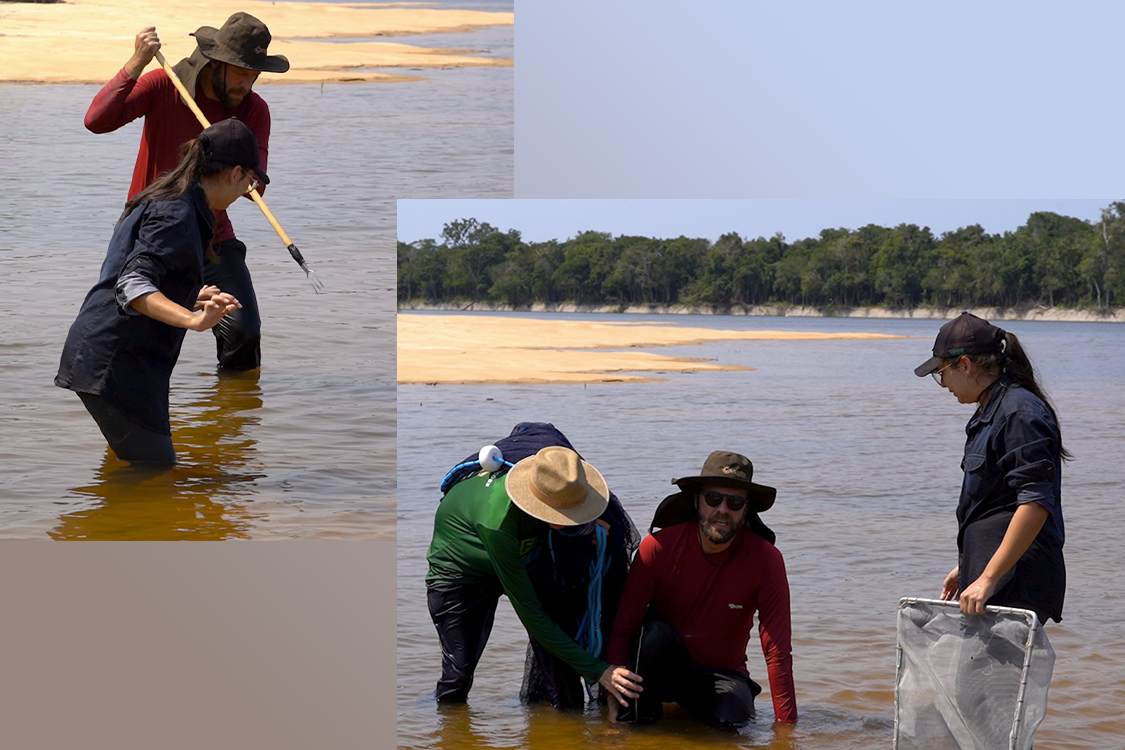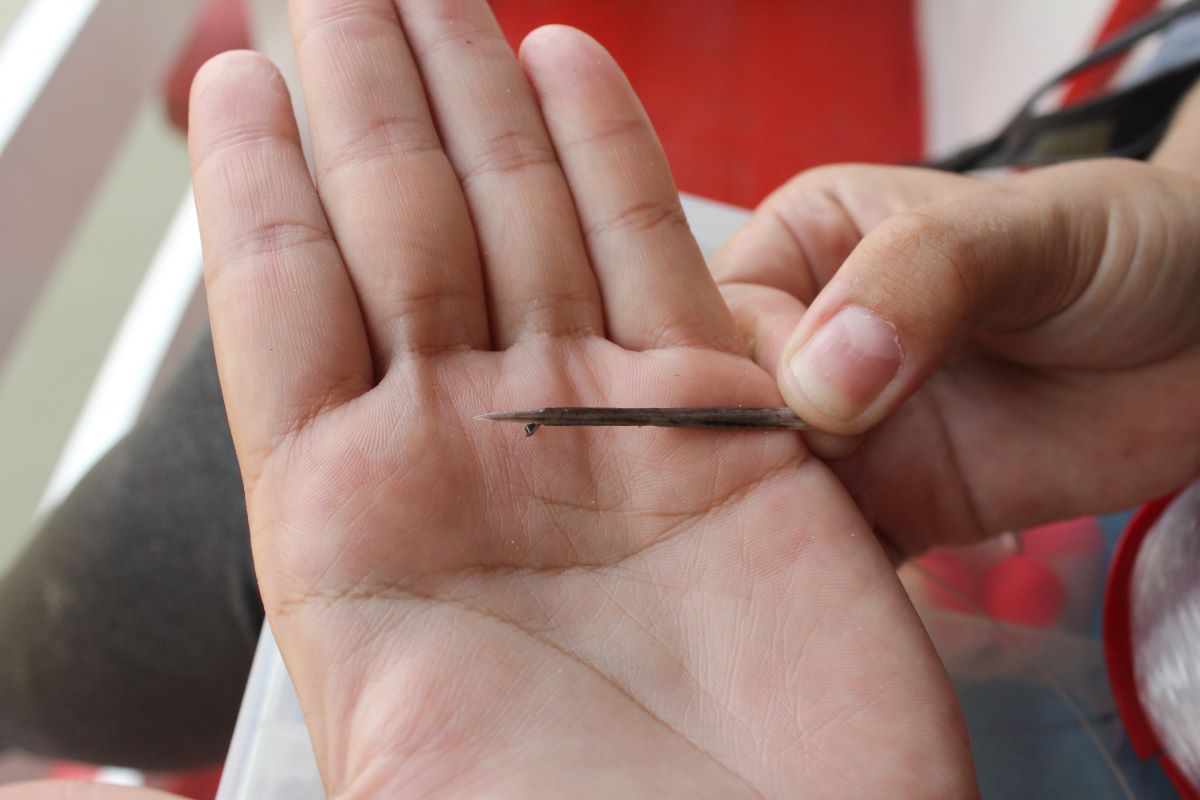

Hunting day: researcher tries to collect a ray and is stung shortly afterwards (photos: Phelipe Janning/Agência FAPESP)
The low severity of the injury, rapid medical attention and appropriate care meant that the researcher was able to return to work on the same day he was stung by a venomous fish. In the Amazon, cases often get worse because a lack of specialized care.
The low severity of the injury, rapid medical attention and appropriate care meant that the researcher was able to return to work on the same day he was stung by a venomous fish. In the Amazon, cases often get worse because a lack of specialized care.

Hunting day: researcher tries to collect a ray and is stung shortly afterwards (photos: Phelipe Janning/Agência FAPESP)
By André Julião and Phelipe Janning | Agência FAPESP – At the moment of the sting, the pain is excruciating. It is as if, after hitting the victim, the ray pushes the tip of the stinger to penetrate further into the human muscle.
These were some of the impressions that researcher Thiago Loboda, a postdoctoral researcher at the Museum of Zoology of the University of São Paulo (MZ-USP), had in the first moments after being stung on the right foot by a Potamotrygon motoro.
The species is one of the most common in the Amazon and is therefore responsible for most of the accidents involving this animal. The case occurred during the collections of the DEGy Negro River Expedition, which took place in February and traveled the Negro River and tributaries in the states of Amazonas and Roraima, Brazil, in search of electric fish and rays. Four of the six ray species found in the Negro River basin were collected, along with a possible new species. Loboda did not catch the animal that injured him.
The expedition is part of the “Diversity and Evolution of Gymnotiformes (DEGy)” project, supported by FAPESP, and the reports are part of the Field Diary – Negro River series.
“I was lucky. The animal was small and even though my foot was hit by the two stings, the shoe I was wearing prevented them from penetrating any further,” Loboda said in April from his workstation at MZ-USP with the wound almost completely healed.
Being on river beaches is a constant risk of accidents with rays, even more so in the Amazon. Of the 34 freshwater species in Brazil, more than 30 are found in the Amazon basin.

: The rays remain stationary and partially buried in the sand, where they blend in with the bottom of rivers and igarapés (photo: André Julião/Agência FAPESP)
In a study that analyzed reports of aquatic animal accidents over a seven-year period nationwide, 66% of the cases occurred in the northern region, 92% of which were caused by rays.
“These are the reported cases. Most of the time, however, the people affected live in isolated places, without access to medical care, and the injuries get worse, with necrosis and infections,” Vidal Haddad Junior, professor at the São Paulo State University’s Botucatu School of Medicine (FMB-UNESP), who has been studying accidents involving aquatic animals for more than 30 years, told Agência FAPESP (read more at: agencia.fapesp.br/24301).
More than the ray’s serrated sting, what makes accidents worse is the venom contained in the mucus that covers this natural weapon. In addition to the venom, it also contains enzymes with proteolytic properties, i.e. which break down the proteins present in human cells and tissues.

One of the stings that injured the researcher’s foot. Covered in poisonous mucus and full of tissue-destroying enzymes, it causes severe pain and necrosis (photo: André Julião/Agência FAPESP)
The venom has a vasoconstrictive effect, which narrows the blood vessels, causing severe pain by making it difficult for blood to pass through. The same effect also causes necrosis, where the tissue dies from a lack of blood supply.
In a study that followed 84 patients in the Southeast and Center-West of Brazil, where these accidents are also recurrent, Haddad documented the occurrence of necrosis in 90% of cases.
Rapid care
Fortunately, after the accident on the Jauaperi River on February 22, Loboda was quickly taken to a basic health unit in the Moura district, part of the municipality of Barcelos. There, he was seen by Dr. Sofia Prata Piña, who happened to be a former student of Haddad Junior at FMB-UNESP, who presented his case to the specialist over the phone.
“They soaked my foot in hot water, washed it intensely, and gave me a local anesthetic and an injectable antibiotic. I also took another antibiotic orally for a week. The pain was under control by then, but at the time it’s really intense,” reports Loboda.
Reports of 24 hours of pain are common. Although it causes great morbidity and can cause wounds that take up to three months to heal, there is no serum for stingray venom that could reduce pain and the likelihood of necrosis.
Soaking the affected limb in hot water for 30 to 90 minutes is one of the most effective ways to reduce pain, according to Haddad. Antibiotics are necessary to prevent infection from bacteria that invade the affected tissue.
Usually living in places where there is no medical care, patients resort to widespread false treatments that include herbal teas, tobacco, urine and boiled eggs applied to the wound site. These practices have no proven efficacy and can even worsen the condition.
During the expedition, there was no shortage of reports of accidents treated in this way. On one beach on the Preto River, there were three or four accidents during this year’s carnival alone. The nearest medical service was in Santa Isabel do Rio Negro. In the most common means of transportation in the Amazon region, the rabeta, a canoe with a small engine, the trip took a whole day.
View all the episodes of the Field Diary – Negro River series at: agencia.fapesp.br/en/field-diary.
Republish
The Agency FAPESP licenses news via Creative Commons (CC-BY-NC-ND) so that they can be republished free of charge and in a simple way by other digital or printed vehicles. Agência FAPESP must be credited as the source of the content being republished and the name of the reporter (if any) must be attributed. Using the HMTL button below allows compliance with these rules, detailed in Digital Republishing Policy FAPESP.





